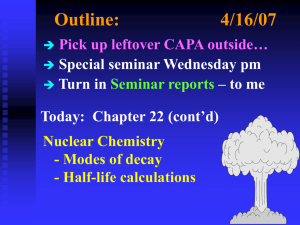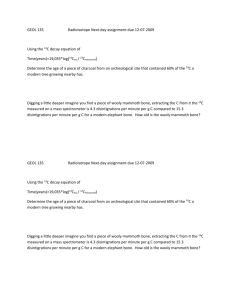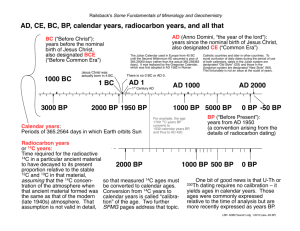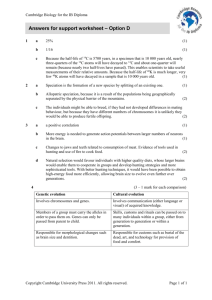Document 11985284
advertisement
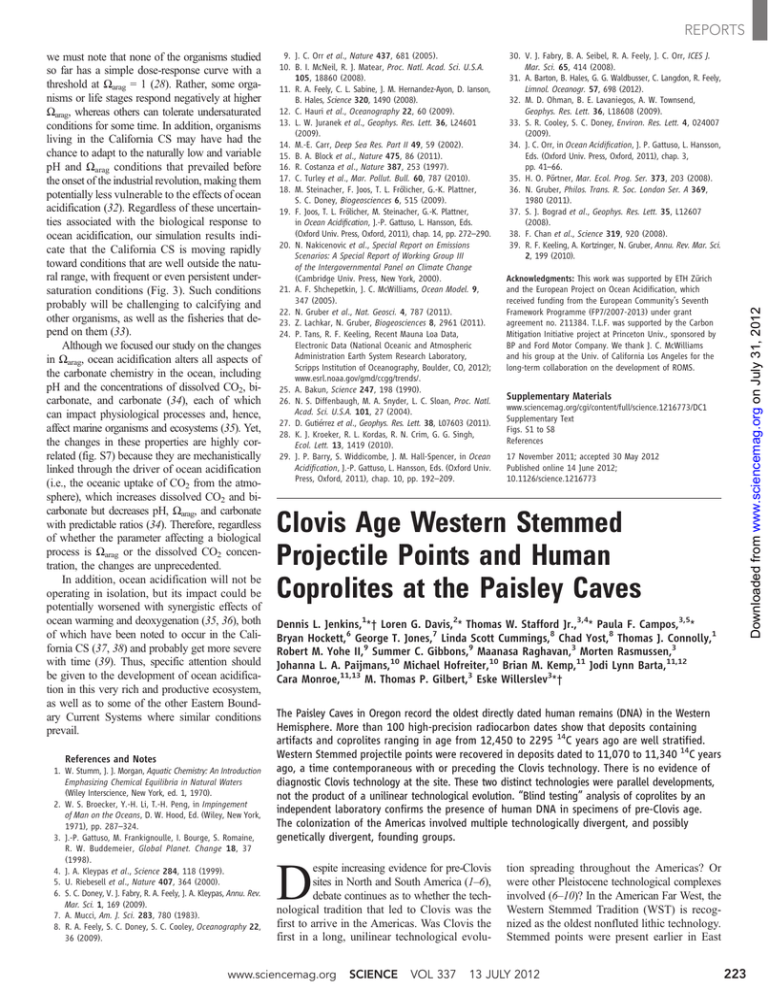
REPORTS References and Notes 1. W. Stumm, J. J. Morgan, Aquatic Chemistry: An Introduction Emphasizing Chemical Equilibria in Natural Waters (Wiley Interscience, New York, ed. 1, 1970). 2. W. S. Broecker, Y.-H. Li, T.-H. Peng, in Impingement of Man on the Oceans, D. W. Hood, Ed. (Wiley, New York, 1971), pp. 287–324. 3. J.-P. Gattuso, M. Frankignoulle, I. Bourge, S. Romaine, R. W. Buddemeier, Global Planet. Change 18, 37 (1998). 4. J. A. Kleypas et al., Science 284, 118 (1999). 5. U. Riebesell et al., Nature 407, 364 (2000). 6. S. C. Doney, V. J. Fabry, R. A. Feely, J. A. Kleypas, Annu. Rev. Mar. Sci. 1, 169 (2009). 7. A. Mucci, Am. J. Sci. 283, 780 (1983). 8. R. A. Feely, S. C. Doney, S. C. Cooley, Oceanography 22, 36 (2009). 9. J. C. Orr et al., Nature 437, 681 (2005). 10. B. I. McNeil, R. J. Matear, Proc. Natl. Acad. Sci. U.S.A. 105, 18860 (2008). 11. R. A. Feely, C. L. Sabine, J. M. Hernandez-Ayon, D. Ianson, B. Hales, Science 320, 1490 (2008). 12. C. Hauri et al., Oceanography 22, 60 (2009). 13. L. W. Juranek et al., Geophys. Res. Lett. 36, L24601 (2009). 14. M.-E. Carr, Deep Sea Res. Part II 49, 59 (2002). 15. B. A. Block et al., Nature 475, 86 (2011). 16. R. Costanza et al., Nature 387, 253 (1997). 17. C. Turley et al., Mar. Pollut. Bull. 60, 787 (2010). 18. M. Steinacher, F. Joos, T. L. Frölicher, G.-K. Plattner, S. C. Doney, Biogeosciences 6, 515 (2009). 19. F. Joos, T. L. Frölicher, M. Steinacher, G.-K. Plattner, in Ocean Acidification, J.-P. Gattuso, L. Hansson, Eds. (Oxford Univ. Press, Oxford, 2011), chap. 14, pp. 272–290. 20. N. Nakicenovic et al., Special Report on Emissions Scenarios: A Special Report of Working Group III of the Intergovernmental Panel on Climate Change (Cambridge Univ. Press, New York, 2000). 21. A. F. Shchepetkin, J. C. McWilliams, Ocean Model. 9, 347 (2005). 22. N. Gruber et al., Nat. Geosci. 4, 787 (2011). 23. Z. Lachkar, N. Gruber, Biogeosciences 8, 2961 (2011). 24. P. Tans, R. F. Keeling, Recent Mauna Loa Data, Electronic Data (National Oceanic and Atmospheric Administration Earth System Research Laboratory, Scripps Institution of Oceanography, Boulder, CO, 2012); www.esrl.noaa.gov/gmd/ccgg/trends/. 25. A. Bakun, Science 247, 198 (1990). 26. N. S. Diffenbaugh, M. A. Snyder, L. C. Sloan, Proc. Natl. Acad. Sci. U.S.A. 101, 27 (2004). 27. D. Gutiérrez et al., Geophys. Res. Lett. 38, L07603 (2011). 28. K. J. Kroeker, R. L. Kordas, R. N. Crim, G. G. Singh, Ecol. Lett. 13, 1419 (2010). 29. J. P. Barry, S. Widdicombe, J. M. Hall-Spencer, in Ocean Acidification, J.-P. Gattuso, L. Hansson, Eds. (Oxford Univ. Press, Oxford, 2011), chap. 10, pp. 192–209. 30. V. J. Fabry, B. A. Seibel, R. A. Feely, J. C. Orr, ICES J. Mar. Sci. 65, 414 (2008). 31. A. Barton, B. Hales, G. G. Waldbusser, C. Langdon, R. Feely, Limnol. Oceanogr. 57, 698 (2012). 32. M. D. Ohman, B. E. Lavaniegos, A. W. Townsend, Geophys. Res. Lett. 36, L18608 (2009). 33. S. R. Cooley, S. C. Doney, Environ. Res. Lett. 4, 024007 (2009). 34. J. C. Orr, in Ocean Acidification, J. P. Gattuso, L. Hansson, Eds. (Oxford Univ. Press, Oxford, 2011), chap. 3, pp. 41–66. 35. H. O. Pörtner, Mar. Ecol. Prog. Ser. 373, 203 (2008). 36. N. Gruber, Philos. Trans. R. Soc. London Ser. A 369, 1980 (2011). 37. S. J. Bograd et al., Geophys. Res. Lett. 35, L12607 (2008). 38. F. Chan et al., Science 319, 920 (2008). 39. R. F. Keeling, A. Kortzinger, N. Gruber, Annu. Rev. Mar. Sci. 2, 199 (2010). Acknowledgments: This work was supported by ETH Zürich and the European Project on Ocean Acidification, which received funding from the European Community’s Seventh Framework Programme (FP7/2007-2013) under grant agreement no. 211384. T.L.F. was supported by the Carbon Mitigation Initiative project at Princeton Univ., sponsored by BP and Ford Motor Company. We thank J. C. McWilliams and his group at the Univ. of California Los Angeles for the long-term collaboration on the development of ROMS. Downloaded from www.sciencemag.org on July 31, 2012 we must note that none of the organisms studied so far has a simple dose-response curve with a threshold at Ωarag = 1 (28). Rather, some organisms or life stages respond negatively at higher Ωarag, whereas others can tolerate undersaturated conditions for some time. In addition, organisms living in the California CS may have had the chance to adapt to the naturally low and variable pH and Ωarag conditions that prevailed before the onset of the industrial revolution, making them potentially less vulnerable to the effects of ocean acidification (32). Regardless of these uncertainties associated with the biological response to ocean acidification, our simulation results indicate that the California CS is moving rapidly toward conditions that are well outside the natural range, with frequent or even persistent undersaturation conditions (Fig. 3). Such conditions probably will be challenging to calcifying and other organisms, as well as the fisheries that depend on them (33). Although we focused our study on the changes in Ωarag, ocean acidification alters all aspects of the carbonate chemistry in the ocean, including pH and the concentrations of dissolved CO2, bicarbonate, and carbonate (34), each of which can impact physiological processes and, hence, affect marine organisms and ecosystems (35). Yet, the changes in these properties are highly correlated (fig. S7) because they are mechanistically linked through the driver of ocean acidification (i.e., the oceanic uptake of CO2 from the atmosphere), which increases dissolved CO2 and bicarbonate but decreases pH, Ωarag, and carbonate with predictable ratios (34). Therefore, regardless of whether the parameter affecting a biological process is Ωarag or the dissolved CO2 concentration, the changes are unprecedented. In addition, ocean acidification will not be operating in isolation, but its impact could be potentially worsened with synergistic effects of ocean warming and deoxygenation (35, 36), both of which have been noted to occur in the California CS (37, 38) and probably get more severe with time (39). Thus, specific attention should be given to the development of ocean acidification in this very rich and productive ecosystem, as well as to some of the other Eastern Boundary Current Systems where similar conditions prevail. Supplementary Materials www.sciencemag.org/cgi/content/full/science.1216773/DC1 Supplementary Text Figs. S1 to S8 References 17 November 2011; accepted 30 May 2012 Published online 14 June 2012; 10.1126/science.1216773 Clovis Age Western Stemmed Projectile Points and Human Coprolites at the Paisley Caves Dennis L. Jenkins,1*† Loren G. Davis,2* Thomas W. Stafford Jr.,3,4* Paula F. Campos,3,5* Bryan Hockett,6 George T. Jones,7 Linda Scott Cummings,8 Chad Yost,8 Thomas J. Connolly,1 Robert M. Yohe II,9 Summer C. Gibbons,9 Maanasa Raghavan,3 Morten Rasmussen,3 Johanna L. A. Paijmans,10 Michael Hofreiter,10 Brian M. Kemp,11 Jodi Lynn Barta,11,12 Cara Monroe,11,13 M. Thomas P. Gilbert,3 Eske Willerslev3*† The Paisley Caves in Oregon record the oldest directly dated human remains (DNA) in the Western Hemisphere. More than 100 high-precision radiocarbon dates show that deposits containing artifacts and coprolites ranging in age from 12,450 to 2295 14C years ago are well stratified. Western Stemmed projectile points were recovered in deposits dated to 11,070 to 11,340 14C years ago, a time contemporaneous with or preceding the Clovis technology. There is no evidence of diagnostic Clovis technology at the site. These two distinct technologies were parallel developments, not the product of a unilinear technological evolution. “Blind testing” analysis of coprolites by an independent laboratory confirms the presence of human DNA in specimens of pre-Clovis age. The colonization of the Americas involved multiple technologically divergent, and possibly genetically divergent, founding groups. espite increasing evidence for pre-Clovis sites in North and South America (1–6), debate continues as to whether the technological tradition that led to Clovis was the first to arrive in the Americas. Was Clovis the first in a long, unilinear technological evolu- D www.sciencemag.org SCIENCE VOL 337 tion spreading throughout the Americas? Or were other Pleistocene technological complexes involved (6–10)? In the American Far West, the Western Stemmed Tradition (WST) is recognized as the oldest nonfluted lithic technology. Stemmed points were present earlier in East 13 JULY 2012 223 Asia and Siberia, and the basic form could have arrived in the Americas before Clovis developed (11–15). Like Clovis, the WST is a New World development sharing basic morphological and technological characteristics with Old World forms. Western Stemmed (WS) projectile points are generally narrow bifaces with sloping shoulders, and many have relatively thick contracting bases (Fig. 1, A to C). They were commonly made on flakes by broad collateral, midline, percussion flaking and finished by pressure flaking. In this, they are morphologically and technologically distinct from the generally broader, concave-based, fluted Clovis points made on large bifacial preforms often thinned by overshot flake technology (16–19) (Fig. 1D). Prismatic blades—long, narrow flakes with triangular cross sections driven from specially prepared cores—are common to Clovis sites outside of western North America (16, 17) and are less common to WST assemblages. Most dated WS projectile points are younger than Clovis, and it has been proposed that they evolved from a single tradition. The possible exceptions are WS projectile points found in strata dated to the Clovis era at the Smith Creek Cave, Cooper’s Ferry, and Bonneville Estates Rockshelter sites. The association of the dates with the points at these sites has not been confirmed and is not widely accepted (fig. S1) (13, 20–24). Here, we describe WST assemblages—including human coprolites—at the Paisley Caves and show that these date to between 11,070 and 11,340 radiocarbon years before the present (14C yr B.P.), confirming that they overlap or precede Clovis (20). We continued to excavate the Paisley Caves from 2009 through 2011. To resolve the question of stratigraphic integrity, we acquired 121 new AMS (accelerator mass spectrometry) radiocarbon dates on samples of terrestrial plants (e.g., Artemisia sp., Atriplex sp.), macrofossils from coprolites, bone collagen, and water-soluble extracts recovered from each of these categories. To date, a total of 190 radiocarbon dates have been produced from the Paisley Caves (tables S1 to S9). These are distributed throughout four 1 Museum of Natural and Cultural History, University of Oregon, Eugene, OR 97403, USA. 2Department of Anthropology, Oregon State University, Corvallis, OR 97331, USA. 3Centre for GeoGenetics, University of Copenhagen, DK 1350 Copenhagen, Denmark. 4 Stafford Research Laboratories Inc., 200 Acadia Avenue, Lafayette, CO 80026, USA. 5Museu da Ciência, Universidade de Coimbra, Largo Marquês de Pombal, 3000-272 Coimbra, Portugal. 6Bureau of Land Management, Nevada State Office, 1340 Financial Boulevard, Reno, NV 89502, USA. 7Department of Anthropology, Hamilton College, Clinton, NY 13323, USA. 8PaleoResearch Institute, 2675 Youngfield Street, Golden, CO 80401, USA. 9Anthropology Program, California State University, Bakersfield, CA 93311, USA. 10Department of Biology, University of York, York Y010 5DD, UK. 11Department of Anthropology and School of Biological Sciences, Washington State University, Pullman, WA 99164, USA. 12Department of Biological and Health Sciences, Madonna University, Livonia, MI 48150, USA. 13Department of Anthropology, University of California, Santa Barbara, CA 93106, USA. *These authors contributed equally to this work. †To whom correspondence should be addressed. E-mail: djenkins@uoregon.edu (D.L.J.); ewillerslev@snm.ku.dk (E.W.) 224 of the caves, although the primary set of highprecision dates represents six dating columns in Caves 2 and 5. DNA analysis has been completed on 65 coprolites from the site. To investigate whether non-endogenous human DNA may have leached into samples, we also tested Camelidae, Felidae, and Caprinae coprolites for the presence of ancient human DNA (25). Middens of wood rat (Neotoma sp.) are common in the Paisley Caves, particularly in the North Block of Cave 5 (fig. S2). To investigate whether excavations by rodents disturbed the stratigraphic integrity of the deposits, we dated two profiles there (Fig. 2A and tables S2 and S3) (25). The dates in each are stratigraphically and chronologically well ordered. Beginning just below a layer of Mount Mazama O tephra—dated to 6790 T 15 14C yr B.P. in Cave 2 and ~6850 years regionally (26)—the ages in profiles I and II range from 6980 T 15 to 12,450 T 30 14C yr B.P. WS projectile point 1294-PC-5/6D-47-1 (Fig. 1B), a biface, a polished probable foodprocessing stone (fig. S3), and eight pieces of lithic debitage were recovered from lithostratigraphic units LU1 and LU2 in the North Block, which are of late Pleistocene–early Holocene age. Projectile point 1294-PC-5/6D-47-1 was recovered from sifted LU2 [LU1a in (4)] sediments in excavation unit 5/6D (fig. S2) and may date from 11,135 to 11,600 14C yr B.P. (Table 1) (25). A trench connecting the North and South Blocks provided continuous stratigraphic exposure across the mouth of Cave 5 (fig. S2). Profiles III and IV, at the intersection of this trench with the South Block, reveal well-stratified, highly indurated sandy sediments (LU2 and LU3) underlain by gravelly LU1 deposits. Ages here range from 7700 T 20 to 12,410 T 25 14C yr B.P. (Fig. 2, B and C, and tables S4 and S5). Organic materials in basal LU1 sediments of profile III date to 12,410 14C yr B.P. The lower portion of overlying LU2 is dated between 11,070 T 25 and 12,405 T 25 14C yr B.P. and is composed of more organic, loamy, and gravelly sand, varying portions of which are highly indurated. The upper portion is dated between 10,855 T 30 14C yr B.P. and ~9500 14C yr B.P. Rodent disturbances were traceable as oval voids filled with loose organic sediments intruded into less organic, compact to cemented LU2 sandy- Fig. 1. Western Stemmed projectile point fragments. (A) 1961-PC-5/18a-10-1. (B) 1294-PC-5/6D-47-1. (C) 1895-PC-5/16A-24. (D) Clovis point from Dent site, Colorado. Edges of (A) and (C) are intensely ground, as indicated by lines paralleling edges and stippling in edge-on view. The notch in (B) is an obsidian hydration cut. [Illustrations by Eric Carlson and George T. Jones] 13 JULY 2012 VOL 337 SCIENCE www.sciencemag.org Downloaded from www.sciencemag.org on July 31, 2012 REPORTS REPORTS Fig. 2. (A) Dating column profiles I and II in North Block, Cave 5. (B) Dating column profile III. (C) Dating column profile IV. www.sciencemag.org SCIENCE VOL 337 13 JULY 2012 Downloaded from www.sciencemag.org on July 31, 2012 silt or low organic gray sandy-gravelly LU1 sediments. Dated artifacts, charcoal, and the KOH-soluble fraction from the charcoal within stratigraphic disturbances indicate that they occurred between 9500 and 10,250 14C yr B.P. (table S10). Three additional WS projectile point fragments were recovered from LU2 sediments with a chert flake tool and 165 pieces of lithic debitage (Fig. 3A) (25). Point 1895-PC-5/16A-24 (Fig. 1C) was found in situ laying horizontally, solidly encased in a compact silt lens formed by a brief pooling of water on the cave floor (Fig. 3, fig. S4, and table S11). This projectile point was on the cave floor when the lens formed and remained undisturbed until discovery (25). Atriplex sp. and Artemisia sp. twigs sampled in the east wall of unit 5/16A ~40 cm east of point 1895-PC-5/16A24, at elevations 1365.97, 1365.93, and 1365.89 m, were dated to 11,070 T 25, 11,500 T 30, and 11,815 T 25 14C yr B.P., respectively. Two human coprolites at elevations 1365.91–.96 and 1365.88 in unit 5/16A were dated to 11,205 T 25 and 11,340 T 30 14C yr B.P., respectively. Projectile point 1895-PC-5/16A-24 was dated between 11,070 and 11,340 14C yr B.P. (Figs. 2B and 3B, fig. S4, and table S11). WS projectile point 1895-PC-5/16A-23-6a (not illustrated) was recovered with 37 pieces of lithic debitage sifted from organic sediments directly overlying the silt lens. Bracketing dates for this projectile point are 10,855 14C yr B.P. (1366.05 to 1366.00 m) and 11,070 (1365.97 m). WS projectile point 1895-PC-5/18a-10-1 was recovered ex situ from sifted sediments in excavation unit 5/18a— located 75 cm from projectile point 1895-PC5/16A-24 (Fig. 3) (25)—between 1366.10 and 1366.05 m and is bracketed between dates 10,200 and 10,855 14C yr B.P. (Table 1). A Camelidae coprolite was recovered in situ below the silt lens at 1365.85 m (table S11). It produced a macrofossil age of 12,125 T 30 14C yr B.P.; however, the age of its water-soluble extract was 11,315 T 25 14C yr B.P. This is the only instance of fractions differing by hundreds of years between macrofossils and their extracted solutes in 12 such tests (25). Three coprolites containing ancient human DNA (aDNA)—results from two of which were replicated by laboratories in Copenhagen and York in blind testing and found to relate to mitochondrial DNA founding haplogroup A (25)—were recovered in close horizontal proximity. Dates on the macroflora and solute fractions, respectively, from these three coprolites were 12,265 T 25 and 12,260 T 30 14 C yr B.P.; 12,165 T 25 and 12,050 T 25 14C yr B.P., and 11,205 T 25 and 11,250 T 25 14C yr B.P. (tables S1 and S12). The two oldest of these were recovered lower in the deposits of adjacent excavation unit 5/11B (fig. S2). Presumably, they would have been contaminated in the manner of the Camelidae coprolite had water reached them. Their concordant ages indicate that the effects of water were limited spatially, stratigraphically, and in volume. The new human aDNA 225 REPORTS Table 1. Western Stemmed projectile point proveniences and their bracketing radiocarbon dates. Two independent laboratories provided the dual dates for specimen 1294-PC-5/6D-47-1. Unit Elevation (m) Upper bracketing age and elevation (m) Lower bracketing age and elevation (m) 1294-PC-5/6D-47-1 5/6D 1366.06 to 1366.01 1895-PC-5/16A-24 1895-PC-5/16A-23-6A 1961-PC-5/18a-10-1 5/16A 5/16A 5/18a 1365.93 1366.01 to 1365.96 1366.10 to 1366.05 10,050 T 50 (1366.40 to 1366.35) 10,965 T 50 11,070 T 25 (1365.97) 10,855 T 30 (1366.05 to 1366.00) 10,200 T 35 (1366.09) 12,140 T 70 (1365.91 to 1365.86) 12,260 T 60 11,340 T 50 (1365.88) 11,070 T 25 (1365.97) 10,855 T 30 (1366.05 to 1366.00) results (table S12) confirm our previous findings that humans with DNA founding haplogroup A had occupied the site in pre-Clovis times (3). In Cave 2, dates for profiles V and VI, beginning at the base of the Mount Mazama tephra, range between 6790 T 15 and 12,320 T 35 14C yr B.P. (Fig. 4 and fig. S5). All Cave 2 dates between 10,980 T 20 and 12,425 T 30 14C yr B.P. come from LU1 and LU2, both of which are easily distinguished from LU3 by their low organic, sand, and gravel content. LU1 contains water-rounded boulders and sandy gravels. It is covered by up to 30 cm of brown gravelly sand (LU2). The LU2 sands are partially capped by a thin alluvial silt lens with a mean age of 11,035 14 C yr B.P. Artemisia charcoal from the surface of hearth 2/6-4 at elevation 1365.48 m was dated to 10,020 T 30 14C yr B.P., whereas Artemisia charcoal recovered at lower elevations—1365.40 m and 1365.35 to 1365.30 m from within the hearth depression—was dated to 11,005 T 30 and 11,055 T 35 14C yr B.P (Fig. 4B and table S1). Because the younger sample was taken from the LU2-LU3 stratigraphic boundary where charcoal is common, and LU2—into which the hearth was excavated—is an incombustible, low-organic matrix, the 10,020 T 30 14C yr B.P. sample is interpreted as younger charcoal associated with LU3. We accept the age of 11,005 14C yr for this hearth. The hearth was surrounded by obsidian debitage and burned bone. Stone artifacts in undisturbed LU2 deposits at and below the hearth include 228 pieces of lithic debitage, a biface, a polished and chipped probable food-processing stone (fig. S6), and a flake tool. The pre-Clovis context of the probable food-processing stone at elevation 1365.28 m (not associated with the hearth) is established by dates on an Artiodactyla rib (11,930 T 25 14C yr B.P.) and an Equus sp. maxilla (11,740 T 25 14C yr B.P.) found below and above it at elevations of 1365.25 and 1365.31 m, respectively. LU2 transitions abruptly upward into more organic LU3 sediments that are rich in bat guano and are dated between 6790 T 15 and 10,585 T 30 14C yr B.P. (table S1). DNA can be carried through sedimentary deposits by water (rain, sheet wash, capillary fringe solutions) and urine (3, 27). We initially (3, 28–30) addressed the question of DNA leaching by testing sediment around the coprolites, as well as Neotoma fecal pellets, for human aDNA; however, no human aDNA was detected. Neotoma sp. (wood rat) aDNA was extracted from Neotoma fecal pellets, and Callospermophilus lateralis 226 Downloaded from www.sciencemag.org on July 31, 2012 Specimen no. Fig. 3. (A) Horizontal distribution of Western Stemmed projectile points and in situ lithic debitage in excavation units 5/16A and 5/18A. (B) Vertical distribution of artifacts relative to acceptably dated coprolites and dating column samples. (golden-mantled ground squirrel) aDNA was obtained from rodent bones near the coprolites, demonstrating that endogenous DNA survives in the material and the aDNA extraction techniques were producing reliable results (3, 28). Further tests were undertaken to investigate for potential leaching of modern DNA or aDNA 13 JULY 2012 VOL 337 SCIENCE by attempting to extract human aDNA from dry Neotoma urine and from Neotoma, pronghorn, and mountain sheep fecal pellets. Again, no human aDNA was detected. DNA moving in rainwaters or urine could contaminate underlying coprolites with younger DNA. To detect DNA translocation, we made www.sciencemag.org Downloaded from www.sciencemag.org on July 31, 2012 REPORTS Fig. 4. (A) Dating column profile V, excavation unit 2/4. (B) Dating column profile VI, excavation unit 2/6. 26 14C measurements on paired macrofossils and water-soluble fractions on nine coprolites and three 1-cm-thick sediment samples. Younger solutes would indicate potential DNA contamination from younger overlying strata (table S9). In seven coprolites, paired fractions had statistically similar ages. Another coprolite’s solutes were 165 14C yr older than macrofossils, and a camelid coprolite’s solutes were 810 14C yr younger than macrofossils. Sediment solutes and macrofossils exhibit differential dating of 85 to 180 14 C yr. Urine-cemented sands accumulating at ~1 cm per 50 to 80 years have time-averaging problems, whereas instantaneous deposits such as coprolites enable accurate solute-macrofossil interpretations. Radiocarbon data, mummified macrofossils, and struvite accumulations are evidence that the Paisley Caves rarely experienced wetting events that could transport aDNA into older strata. Radiocarbon measurements detect nanograms of carbon contamination, but a few hundred exogenous DNA base pairs—femtogram and smaller amounts—could be present and not detectable by 14 C dating. Younger DNA contamination is not indicated but could exist. Deposition in the caves is generally rapid, normally burying human-size (diameter 2 to >3 cm) coprolites below the penetration depth of surface water or urine within 225 radiocarbon years. If human DNA were introduced into nonhuman coprolites, it was most likely within a few hundred years of deposition, not thousands of years. Previous DNA findings of mitochondrial founding haplogroup A were confirmed by obtaining matching sequences from coprolites in blind test experiments at two independent laboratories, of which one (1830-PC-5/11B-33-101) is dated to a pre-Clovis age (12,165 T 25 14C yr B.P.), one to about Clovis times (11,205 T 25 14C yr B.P.), and one to the mid-Holocene (5750 T 15 14C yr B.P.). The Paisley Caves’ archaeology, geoarchaeology, and DNA analyses all indicate initial human occupation of the northern Great Basin by at least 12,300 14C yr B.P. (3, 28). The only chronologically diagnostic late Pleistocene technology at the Paisley Caves is related to the WST. We have firmly dated two WS projectile points to Clovis (10,800 to 11,050 14C yr B.P.) (31) and earlier times (Table 1) and stratigraphically dated a third to about the same or even earlier times. There is no evidence of diagnostic Clovis technology in the site assemblage (25). Although stemmed points and seaworthy watercraft were present in late Pleistocene Asia www.sciencemag.org SCIENCE VOL 337 thousands of years before the Paisley Caves were occupied, there is no direct correlate for WST technology in Asia. The Paisley Caves evidence suggests that the WST and Clovis complexes were contemporaneous and parallel—not unilinear—North American technological developments (18, 19). The Paisley Caves evidence supports the hypothesis that the WST was an indigenous development in the far western United States, whereas Clovis may have developed independently in the Plains and Southeast (11, 19). References and Notes 1. T. D. Dillehay et al., Science 320, 784 (2008). 2. J. M. Adovasio, D. R. Pedler, in Entering America: Northeast Asia and Beringia Before the Last Glacial Maximum, D. B. Madsen, Ed. (Univ. of Utah Press, Salt Lake City, 2004), chap. 5. 3. M. T. P. Gilbert et al., Science 320, 786 (2008). 4. D. L. Jenkins, in Paleoindian or Paleoarchaic: Great Basin Human Ecology at the Pleistocene-Holocene Transition, K. Graf, D. Schmidt, Eds. (Univ. of Utah Press, Salt Lake City, 2007), chap. 4. 5. M. R. Waters et al., Science 334, 351 (2011). 6. B. T. Lepper, R. Bonnichsen, New Perspectives on the First Americans (Center for the Study of the First Americans, Texas A&M Univ. Press, College Station, TX, 2004). 7. D. J. Meltzer, First Peoples in a New World: Colonizing Ice Age America (Univ. of California Press, Berkeley, 2009). 13 JULY 2012 227 REPORTS 19. 20. 21. 22. 23. 24. 25. 26. 27. 28. 29. 30. 31. West, D. Rhode, Ed. (Univ. of Utah Press, Salt Lake City, 2012), chap. 2. L. G. Davis, S. C. Willis, S. J. Macfarlan, in Meetings at the Margins: Prehistoric Cultural Interactions in the Intermountain West, D. Rhode, Ed. (Univ. of Utah Press, Salt Lake City, 2012), chap. 3. L. G. Davis, C. E. Schweger, Geoarchaeology 19, 685 (2004). J. A. Willig, C. M. Aikens, in Early Human Occupation in Far Western North America: The Clovis-Archaic Interface, J. A. Willig, C. M. Aikens, J. L. Fagan, Eds. (Anthropological Papers No. 21, Nevada State Museum, Carson City, NV, 1988), pp. 1–40. T. Goebel, K. Graf, B. Hockett, D. Rhode, in On Shelter’s Ledge: Histories, Theories and Methods of Rockshelter Research, M. Kornfeld, S. Vasil’ev, L. Miotti, Eds. (British Archaeological Reports, Oxford, 2007), pp. 147–161. K. Graf, in Paleoindian or Paleoarchaic: Great Basin Human Ecology at the Pleistocene-Holocene Transition, K. Graf, D. Schmidt, Eds. (Univ. of Utah Press, Salt Lake City, 2007), chap. 5. R. L. Kelly, Quat. Int. 109–110, 133 (2003). See supplementary materials on Science Online. C. R. Bacon, J. Volcanol. Geotherm. Res. 18, 57 (1983). J. Haile et al., Mol. Biol. Evol. 24, 982 (2007). See supplementary materials in (3). H. Poinar et al., Science 325, 148a (2009). M. T. P. Gilbert et al., Science 325, 148b (2009). M. R. Waters, T. W. Stafford Jr., Science 315, 1122 (2007). Acknowledgments: Support for the Paisley Caves Project was provided by NSF grant 0924606; the Danish National Research Foundation; the U.S. Bureau of Land Management; the Extinction Debt and Windows of Conservation Opportunity in the Brazilian Amazon Oliver R. Wearn,1,2 Daniel C. Reuman,1,3 Robert M. Ewers1* Predicting when future species extinctions will occur is necessary for directing conservation investments but has proved difficult. We developed a new method for predicting extinctions over time, accounting for the timing and magnitude of habitat loss. We applied this to the Brazilian Amazon, predicting that local extinctions of forest-dependent vertebrate species have thus far been minimal (1% of species by 2008), with more than 80% of extinctions expected to be incurred from historical habitat loss still to come. Realistic deforestation scenarios suggest that local regions will lose an average of nine vertebrate species and have a further 16 committed to extinction by 2050. There is a window of opportunity to dilute the legacy of historical deforestation by concentrating conservation efforts in areas with greatest debt. n recent decades, there have been unprecedented rates of habitat loss, fragmentation, and degradation, especially in the speciesrich tropics (1), leading to estimates of resulting species extinctions that are rarely less than catastrophic (2). Extinction does not, however, immediately follow changes in habitat extent or quality. Instead, a process of time-delayed community “relaxation” usually occurs (3, 4), where species progressively disappear over time. The term “extinction debt” (5) refers to any future biodiversity losses that current or past habitat I 1 Imperial College London, Silwood Park, Ascot SL5 7PY, UK. Zoological Society of London, Institute of Zoology, London NW1 4RY, UK. 3Rockefeller University, New York, NY 10065, USA. 2 *To whom correspondence should be addressed. E-mail: r.ewers@imperial.ac.uk 228 destruction will incur but which have yet to be realized because of time delays in extinction. This time delay offers a window of conservation opportunity, during which it is possible to restore habitat or implement alternative measures to safeguard the persistence of species that are otherwise committed to extinction. The Brazilian Amazon harbors some 40% of the world’s tropical forest (6) and a substantial proportion of global biodiversity (7) but has also been host to the majority of tropical deforestation that has occurred in recent decades (1). There has been much debate over the future of the Brazilian Amazon and especially the prospects for biodiversity in the region (6, 8, 9). Quantitative estimates of resulting species loss have rarely been made (10), although we know that the number of threatened bird species in the Amazon is likely 13 JULY 2012 VOL 337 SCIENCE archaeological field school and the Museum of Natural and Cultural History, University of Oregon; the Keystone Archaeological Research Fund, Oregon State University; the Bernice Peltier Huber Charitable Trust; the Great Basin Paleoindian Research Unit of the University of Nevada, Reno; Playa Fellowship Residency grants; and D. Dana, A. Hurley, S. Kohntopp, R. Engle, Origer Associates Inc., and other private contributors. P. Bauman and Enertek Solutions provided high-tech lighting in the caves in 2011. D. Kennett and B. J. Culletan contributed ultrafiltration and XAD AMS radiocarbon dating of three paleontological and two cordage samples. M. Rondeau analyzed all of the lithic debitage and tools from reliable contexts at the site, verifying Jones’ analysis. E. Carlson illustrated the projectile points. T. Goebel, D. Grayson, D. Madsen, and an anonymous individual reviewed drafts of the manuscript. G. McDonald, E. Scott, and E. Davis identified paleontological specimens and consulted us about taxonomy. Paisley Caves archaeological materials are stored at the University of Oregon under accession nos. 1294, 1374, 1704, 1829, 1830, 1895, 1896, and 1961. The 16S rRNA sequences have been deposited in GenBank under accession nos. JQ734469 to JQ734473. Supplementary Materials www.sciencemag.org/cgi/content/full/337/6091/223/DC1 Materials and Methods Figs. S1 to S12 Tables S1 to S19 References (32–47) 27 December 2011; accepted 31 May 2012 10.1126/science.1218443 to triple over the coming decades because of the continued process of deforestation (11). To address this problem, we built a modeling framework that expands on the species-area relationship (SAR) (12, 13). SARs provide a powerful way of estimating the final, equilibrium level of extinction caused by habitat losses (14, 15) but provide no information on the timing of extinctions or on the extinction debt remaining at a given time. Our improved framework gives estimates of extinctions and debt remaining at all times during and after a sequence of habitat destruction events. Assume that at time t = 0 we have a patch of uniform habitat of area A(0) and initial equilibrial species richness S(0) = Seq(0) = cA(0)z. Here, z is the exponent of the SAR and c is a constant (12). The patch is subjected to a subsequent pattern of habitat destruction, so that the remaining area A(t) at time t is less than A(0). If Seq(t) = cA(t)z is the equilibrium number of species that would eventually remain if habitat destruction ceased at time t, then we assume, following empirical (16) and theoretical (3, 17) expectations, that the rate of community relaxation to this equilibrium is proportional to the difference between current richness, S(t), and equilibrium richness: dS ¼ −kðS − Seq Þ ¼ −kðS − cAz Þ dt ð1Þ Here, k is a relaxation rate constant (10). The solution to this is t SðtÞ ¼ Sð0Þe−kt þ e−kt∫ kcAðtÞz ekt dt 0 ð2Þ which can easily be computed numerically for any temporal pattern of habitat destruction A(t). www.sciencemag.org Downloaded from www.sciencemag.org on July 31, 2012 8. R. Bonnichsen, K. L. Turnmire, Eds., Ice Age Peoples of North America: Environments, Origins, and Adaptations of the First Americans (Center for the Study of the First Americans, Texas A&M Univ. Press, College Station, TX, 2005). 9. G. Haynes, The Early Settlement of North America: The Clovis Era (Cambridge Univ. Press. Cambridge, 2002). 10. G. Haynes, Paleoanthropology 2009, 271 (2009). 11. C. Beck, G. T. Jones, Am. Antiq. 75, 81 (2010). 12. J. M. Erlandson et al., Science 331, 1181 (2011). 13. A. Bryan, in The Archaeology of Smith Creek Canyon, Eastern Nevada, D. R. Tuohy, D. L. Rendall, Eds. (Anthropological Papers No. 17, Nevada State Museum, Carson City, NV, 1979), pp. 162–253. 14. A. Bryan, D. R. Tuohy, in Ice Age Peoples of North America: Environments, Origins, and Adaptations of the First Americans, R. Bonnichsen, K. L. Turnmire, Eds. (Center for the Study of the First Americans, Texas A&M Univ. Press, College Station, TX, 2005), pp. 249–263. 15. F. Ikawa-Smith, in Entering America: Northeast Asia and Beringia Before the Last Glacial Maximum, D. B. Madsen, Ed. (Univ. of Utah Press, Salt Lake City, 2004), chap. 10. 16. B. A. Bradley, M. B. Collins, C. A. Hemmings, Clovis Technology (International Monographs in Prehistory no. 17, Ann Arbor, MI, 2010). 17. M. R. Waters, C. D. Pevney, D. L. Carlson, Clovis Lithic Technology: Investigation of a Stratified Workshop at the Gault Site, Texas (Center for the Study of the First Americans, Texas A&M Univ. Press, College Station, TX, 2011). 18. C. Beck, G. T. Jones, in Meetings at the Margins: Prehistoric Cultural Interactions in the Intermountain


